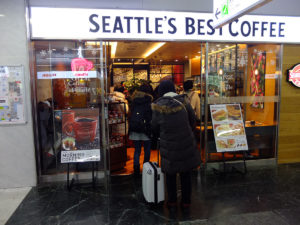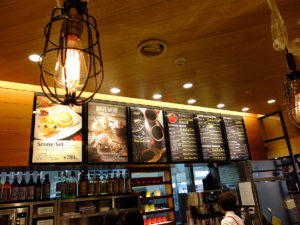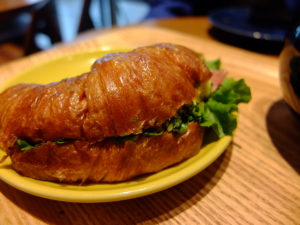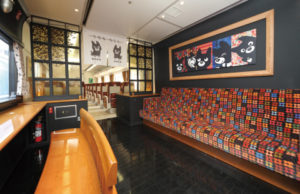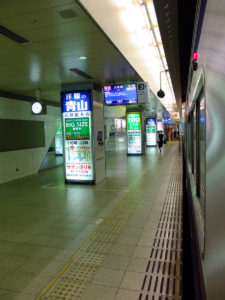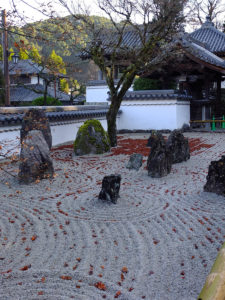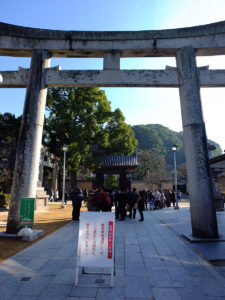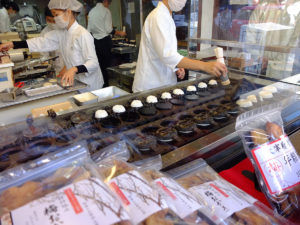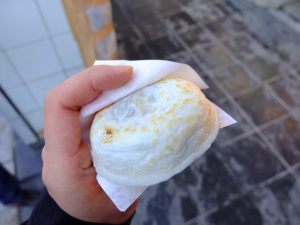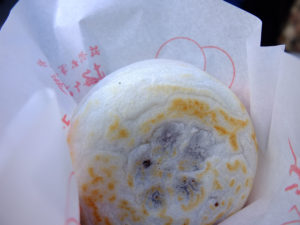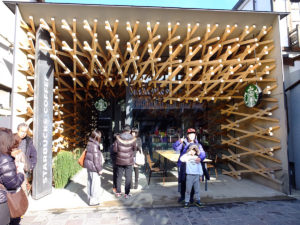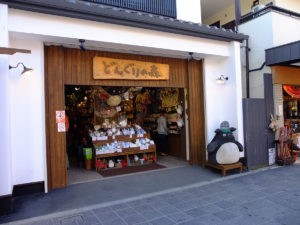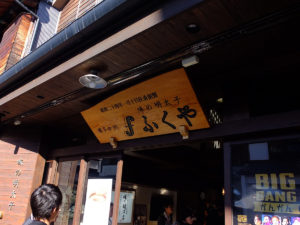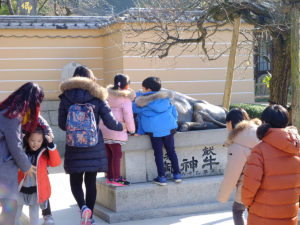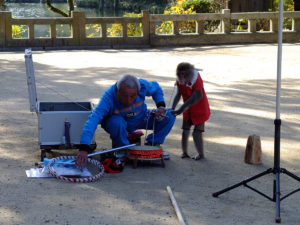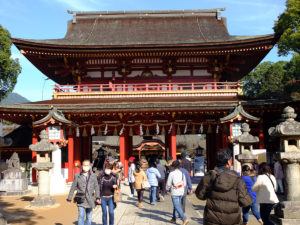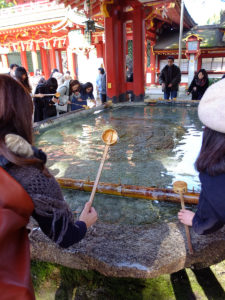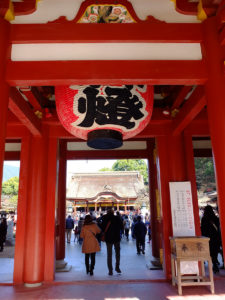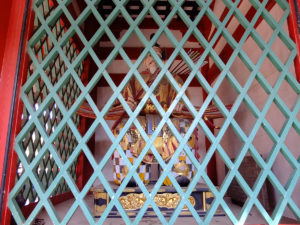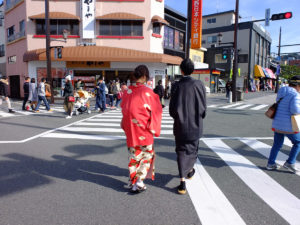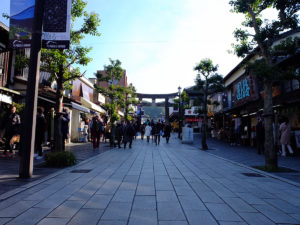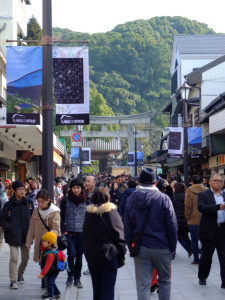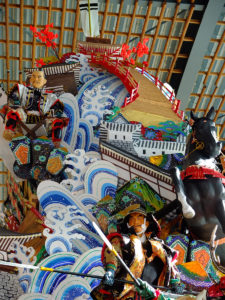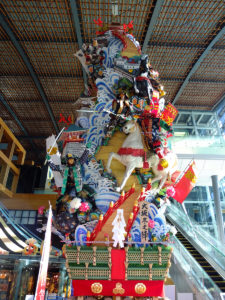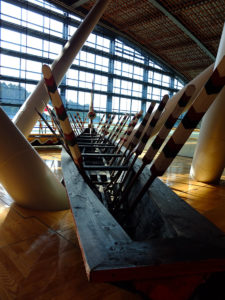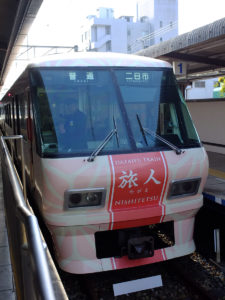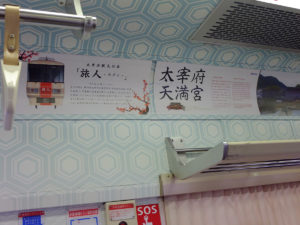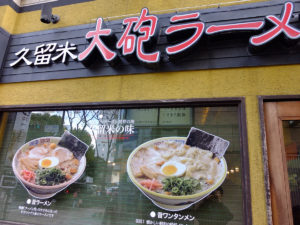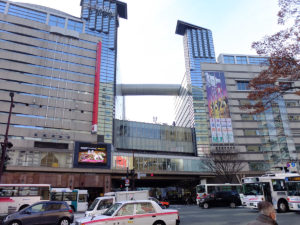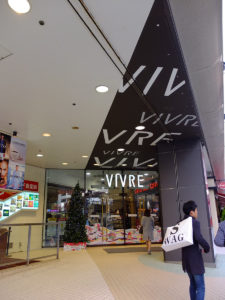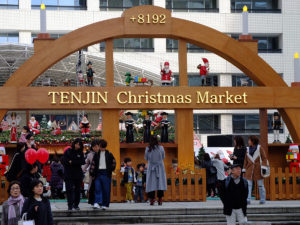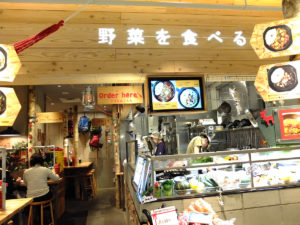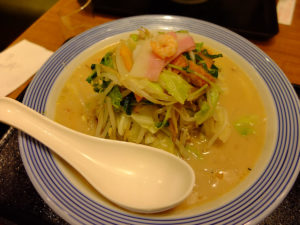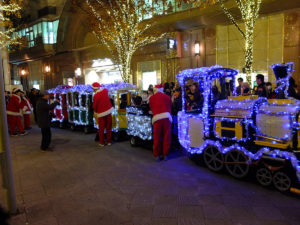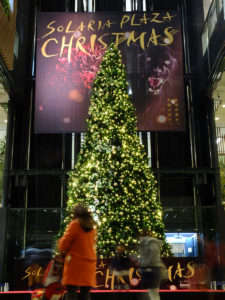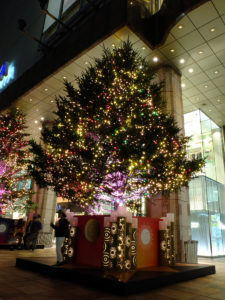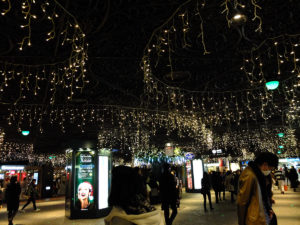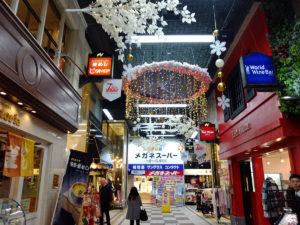I didn’t book breakfast with our rooms, Richmond Hotel didn’t have buffet breakfasts, just 1000Y Japanese or western meal sets. Figured any cafe would be a cheaper.
這次訂房沒有附早餐。Richmond Hotel沒有自助式早餐,而是1000Y的日式或西式套餐。想想隨便一家咖啡館都會比較便宜吧。
Finding breakfast was always a little annoying in Japan (for those that wakes up early like us), the Japanese were very used to a toast or bread plus coffee combo, or udons. Me and my parents preferred something a little more filling, usually coming down to McDonalds and cafes (Doutor which I have a special relationship with). The KITTE B1 had a few restaurants that also served breakfasts but they mostly open at 7:30. At close to 7 the only choices were cafes, which there were several around Hakata station. We first checkout the one in nearby Deitos, the menu looked a little thin. Then the ones in the main station itself. Seattle coffee, just off the side of the main thoroughfare, looked decent with good sandwiches.
在日本早餐總是件煩人事 (對我們這種早起的人來說)。日本人很習慣早餐簡單吃個吐司或麵包加咖啡,或烏龍麵。我和爸媽喜歡吃的稍微飽一點,通常能選的就只有麥當勞或咖啡館 (尤其是偏愛的Doutor)。KITTE B1有幾家餐廳早上也有營業賣早餐,但大多要7:30才開。近七點時的唯一選項就只有咖啡館了,博多車站附近有不少。第一家附近Deitos那間感覺菜單有點少。接著看車站內的那幾家。就在主通道旁的Seattle Coffee看起來三明治不錯。
The greeter at the door was very friendly and helpful and obviously had plenty of experience with foreigners. He pointed us to find a table first before we had decided on what to order, later when the croissant came cold he noticed us discussing over it and actively asked if we would like to have it heated. The price was a little higher than Doutor, at same time the portions were bigger and better. Dad still went for seconds eitherway.
在門口的店員相當友善,似乎很習慣招呼幫忙外國人。他指引我們在決定點什麼前先找位子坐,之後當可鬆端來是冷的時,大概注意到我們對可鬆指指點點,主動來詢問是否需要幫忙加熱。價錢比Doutor貴一點點,份量和味道是比較好。不過老爸還是又多點了一份。
Day 4 was an extra day that had not been set in stone.
第四天算是多的,沒有預先決定要去哪。
Originally after the railway to Aso was cut, the Aso Boy tourist train had been diverted to run to Mojiko, so it made sense to go to Mojiko/Shimonoseki. Aso Boy was a train designed with a black and white puppy theme and kid friendly, with ball pools, play areas and special parent-child seatings. I figured my parents might want to expience it and maybe consider taking my nephews on it in the future.
原本阿蘇鐵路中斷後,阿蘇男孩觀光列車被調去跑門司港,所以想乾脆就順便去門司港下關。阿蘇男孩是用黑白小狗為主題的觀光列車,適合小孩,車上有球池,遊戲區和特別設計的親子座位。我想讓爸媽體驗一次看會不會想以後帶我姪子們來。
As a side note, it’s faster to take the Shinkansen from Hakata to Kokura then transfer to a local train to Mojiko. The Hakata to Kokura section sees special fare rates (JR West runs it like a commuter segment to compete against JR Kyushu) and non-reserved seats are not much more expensive than the local line express, but can be up to 30 minutes faster.
順帶一提,去門司港搭新幹線到小倉後再轉區間車去會比搭一般特急快。博多到小倉的新幹線票價有特別優惠 (JR西日本把這段當通勤在跑,跟JR九州競爭),自由席不會比一般特急貴多少,但最多可省上30分鐘。
Then for December the Aso Boy train was moved to run to the Huis Ten Bosch theme park in Nagasaki (which I had no interest in going), this removed a major incentive for going to Mojiko. Thus it was thought we might instead go to Dazaifu and return earlier in the day to have a look around Tenjin.
然後阿蘇男孩12月被調去跑長崎的豪斯登堡(沒興趣去),這樣就少了去門司港的一大誘因。於是想想可能去太宰府就好了,完後早點回天神逛逛。
We got a Fukuoka Tourist Pass from the Hakata station information centre. The pass came in two versions, one which included all metro and buses in centre of Fukuoka (820Y) and a wide pass version that also included the Nishitetsu rail to Dazaifu (1340Y). It cost a little more than a regular Dazaifu round trip from Hakata but it saved buying tickets each time, plus there was a chance of us using the metro again later in the day, the pass will then be cheaper.
從博多車站的服務處買了福岡一日卷。一日卷有兩種,一種是包含所有捷運和市區巴士(820Y),另一廣域版還加上到太宰府的西鐵(1340Y)。比來回太宰府貴一點,但省了每一段買車票,加上晚上有可能再去天神,那樣的話一日卷就算起來有便宜到。
To get to Dazaifu from Hakata required going to Tenjin first, walk to the Nishitetsu station, then depending on whether there was a direct service to Dazaifu, potentially another transfer at Futsukaichi. Be careful that sometimes it can be faster to go to Futsukaichi and transfer there anyway as it might be an extra limited express. There is a direct bus from Hakata but it is not covered by the pass and is subject to road traffic.
從博多到大宰府必須先到天神,走到西鐵站後視情況可能有直達太宰府的車,不然要在二日市再轉一次。要留意若是特快車可能先到二日市再轉會比等直達車快。從博多也有直達太宰府的巴士但一日卷並不包含,也需看交通狀況。
Dazaifu is dominated by the Dazaifu Tenmangu Shrine, like a confucian temple equivalent for chinese. The shrine is dedicated to Sugawara Michizane, who was a great scholar and poet back in the Heian period. Originally a member of the court, he was eventually demoted to be a minor official in far away Dazaifu where he died a lonely death. In one of his poems he lamented that he would never see the beloved plum tree in his Kyoto residence. Legend has it that the plum tree loved her master so much it eventually flew to Dazaifu.
太宰府的核心為太宰府天滿宮,類似華人的孔廟。神社祭祀的是菅原道真,平安時代(~900年)一位廣學多聞的大詩人。他原本是朝中大臣,遭到排擠被降為個芝麻小官,發放到遙遠的太宰府,孤獨的度過餘生。在一首詩中他嘆道再也見不到京都家中的梅樹了。傳說梅樹因為對主人的愛慕,有一天飛到了太宰府與他相會。
Stories aside, because of veneration for the man’s wisdom and intellect, it became customary for students looking to get good grades or others looking to become accomplished to come and pay respect at the shrine. The place becomes especially busy before the university or highschool entrance exams kick off.
撇開故事不談,人們因為尊敬菅原的智慧和才華奉他為神,要聯考的學生或想闖出一番事業的人都會來神社求保佑。在大學或高中入學考試前來這裡的人特別多。
Initially we detoured to the nearby Komyozenji temple known for its zen rock gardens, sadly the temple grounds were closed, probably because it was the off seasons and they wanted to do maintenance. No big loss as the temple wasn’t far from the main street anyway.
到太宰府後我們先去附近的光明善寺和他有名的枯山水禪園,不巧的寺院主殿沒有開,大概想入冬淡季維修吧。好在寺院和表參道不遠,沒多走什麼路。
The main street before the shrine is only about 200 metres long, yet there are over 20 shops selling umegae-mochi, meaning plum stick cake. They are grilled rice cakes filled with red beans with little to do with plums outside the plum flower imprint on them. The origin of the cake is not known, all relates to Michizane in some way.
參道只有兩百公尺左右,卻有超過20家梅枝餅店。純粹烤紅豆餅,除了餅上頭壓的梅花外與梅樹無關。餅的來由不可考了,但故事都與菅原有關。
Initially I mistook Kanoya for the popular mochi shop Kasa no Ya, later after we have visited the main shrine we would line up at Kasa no Ya. The one from Kasa no Ya was grilled a little better but the filling much too sweet, felt the one from Kanoya was better to be honest.
一開始我把かのや和名店かさの屋弄混了,不過後來有去かさの屋排隊補吃。かさの屋烤的火候就好,餡有點太甜,真要說可能還喜歡弄錯的かのや多一點。
Amongst the many shops on the main street, a unsuspecting major attraction was the Starbucks. Designed by award winning architect using wood and other natural materials to create a space combining both nature and tradition. The wall and ceiling consisted of criss cross of wooden beams that narrowed in the middle and broaded on either ends, it made the place seemed much longer than it really was. A queue for coffee was quickly building up, we managed to get our coffee and find a table before the crowd showed up and extended the line well outside the shop.
在參道玲瑯滿目的商店中,可能一般不會想到其中的熱門景點會是家星巴克。由名建築師設計,利用木頭和其他自然材料,建構出大自然和傳統交織的空間。牆面和天花板裝置有一根根木頭交錯,中間稍窄兩頭較寬,讓店內有看起來比實際上深長的錯覺。買咖啡的隊伍越來越長了,我們連忙進入買了咖啡後找地方坐下,後頭的隊伍已排到店外了。
There was also a Totoro shop here (the other in Yufuin). The shelves lined with plushies and toys from the Totoro anime by Studio Ghibli. I contemplated getting a white teardrop creature plushie, they weren’t too expensive (by tourist goods standards), but I already had a shelf full of Cinnamorolls and only in recent years have I just managed to stop them multiplying. I ended up buying a CD of Studio Ghibli musics performed in Japanese instruments.
這裡也有一家豆豆龍(另一家在由布院)。架上滿是宮崎駿豆豆龍動漫的娃娃和玩具。我考慮是否買隻小白色豆豆龍,以賣觀光客的價位不算太貴,但我已經有一窩肉桂狗了,近幾年才好不容易停止繁殖,再開一窩似乎不太妙。最後決定買一張日本傳統樂器演奏的宮崎駿音樂集。
While I was mulling over Totoros my parents had become interested in a fish roe shop across the street that promoted products that did not require refrigeration. They wanted to buy some but after asking the staff, found out the ones they liked still required refrigerated.
當我在為豆豆龍煩惱時爸媽也在對街標榜不用冷藏的明太子店逛著。他們對其中一罐有興趣但詢問過店員後才知道他們覺得好吃的剛好是需要冷藏的。
Beyond the first torii is a statue of an ox. It’s said if you touched its head fortune will rub off on you. There was a queue so I didn’t join in.
第一個鳥居後有一隻銅牛。若摸牠頭就能獲得福氣。摸牛的人好多,懶得加入。
Then in the gardens before the main shrine area, there was a performer with a trained monkey. We got there in time to catch the monkey climb a pole and slide around on skates.
在神社主院前的花園裡有個人和他的訓練的猴子在表演。我們到時剛好看到猴子爬竿,還有穿輪鞋滑行。
The main ground of the shrine is enclosed behind a large gate, the courtyard within was packed with people waiting for their chance to go up and pray at the shrine. Was it near exam time? I’m not sure.
神社主殿圈繞在牆內,通過門的廣場上滿是人,等著輪他們上前參拜。快到大考了嗎?不太確定。
One interesting thing was that the guardians of the gate looked to be none other than Michizane himself.
有意思一點是大門兩旁的守門神看似正是菅原自己。
Me and my parents split up once more, I wanted to check out the Kyushu Museum which was for the most part overshadowed by the shrine and ignored by most. My parents headed back to Tenjin for lunch on their own. The transfers were straightforward and they had been to Tenjin a few times now.
之後我們再次各自行動,我想去看看鎮上存在感薄弱的九州博物館,爸媽則回天神吃午餐。轉車難度不大,天神地下街他們也去過一兩次了不至於迷路。
The Kyushu Museum laid off the other side of Tenmangu (turn right at the Tenmangu info centre), do not walk from Komyozenji Temple as that side involved a very steep climb up the stairs. From the Tenmangu you go up a flight of escalators then through a tunnel with people movers.
去九州博物館記得要從天滿宮那側去(天滿宮正殿前服務處右轉),不要從光明善寺那側去,會需要爬很多階樓梯。從天滿宮那上一個手扶梯,過一個有行人輸送帶的隧道就可到博物館。
The Kyushu Museum focused on exhibitions about the cultural transmission between Japan and the rest of Asia, showing excavated artifacts from the Jomon periods onwards, potteries, figurines, arts, these could be compared to other artifacts of similar periods from the rest of asia, showing clear influences.
九州博物館的常設展示以日本和亞洲之間的文化交流,從縄文時代開始展出各類陶瓷,塑像,藝術品,這些展示物跟其他亞洲同時期的物件互相比較,明顯點出彼此之間的相似處。
No photos allowed inside.
裡面不准拍照所以沒相片。
The museum had a rectangular main hall which presented a brief walk through history, then there were side rooms that featured more detailed explanations if one was interested in learning more. Some covered artifact restoration methods, others artifact replica making, expanded period features focusing on the routes which cultures were exchanged with the mainland.
博物館有一個長方形的主廳,如走入時光隧道簡單敘述各朝代文化的主要影響,圍繞主廳的是許多小房間提供細節給有興趣進一步了解的訪客。有些解釋古物修復方法,複製,還有針對大陸間文化傳播的路徑。
Several historic periods were focused on in particularly. Jomon and pre-written history periods where Japan had few influences from the outside world. Big eyed figurines that had come to represent the period, flame shaped pottery and other ornaments.
大致可分為幾段歷史時期。縄文和古時代,日本基本上還是海上孤島,鮮少受外界影響。有這時期代表性的巨眼塑像,還有火焰型陶器和其他裝飾物。
The influx of Buddhism which transformed Japanese religious and societal order. There were many buddhist statues and pagodas. There was a very interested column with hundreds of buddhas carved on it, each with his hands held up in a slightly different pose, when one’s gaze moved between them it seemed the buddhas’s hands waved and beckoned.
佛教的輸入改變了日本的信仰和社會結構。有許多佛像和佛塔。其中有一根很有意思的石柱,上頭刻有上百佛陀,每個佛的手勢都不同,當視線在之間移動時看起來好似每個佛的手都在擺動招手。
The Heian periods trade with China(Tang Dynasty), where envoys were sent on trade missions. On display were examples of the goods that the ships would carry, silk and silver to china, and incense, books, medicines back to Japan. Replicas were available for one to get a first hand feel for what the texture of the clothes and scent of incenses were like.
平安時代與中國(唐)貿易交流繁多,為通商派任過許多遣唐使。銀和綢布賣去中國,運回香,書籍和藥物。展示中陳列了當時船上會載運的貨物樣品,可親身檢視看看這些衣物的質感和香的味道。
In the mongol invasions Fukuoka played centre stage, the mongol forces landed on the shores near Hakata while the defences were mounted from Dazaifu, then the area’s political centre. The main exhibited piece was an urn full of coins recovered from the seabed, it was probably carried upon the ship of a high Mongol official when it sunk off the coast. Outside the exhibition hall, a small scale model of the excavated earthen works that formed part of the forward defences of the area could be found on display.
在蒙古侵日中福岡可是首當其衝,蒙古軍在博多附近登陸,另一邊則以太宰府,當時地區的政治中心,為防衛中心。主要展示的是一個海底撈出來的巨大陶罐,裡頭裝滿銅錢,推測當時是由艘高級蒙古官員的船所載運,在外海遇難沈沒。在展示廳外還有一小模型,描述附近挖掘出的土牆,曾構成太宰府邊境防衛的一環。
Then the influence of Ming ceramics on Japanese crafts. There were also forged seals of the Kyoto and Korean courts, created by pirates and smugglers in the Kyushu areas to conduct illicit businesses in the area.
明朝的陶瓷對日本的陶藝上有著顯著影響。另外由於明朝的禁海令,日本變成需通過朝鮮與中國交流,於是九州的海盜和走私商人仿製了京都和朝鮮的官印,好在兩國間遊走。
The whole place took about an hour and a half to browse through at a semi-detailed pace. It is a shame the place is not more popular as the items displayed and the way they were exhibited told a very interesting story about the back and forth between the island and the continent.
整個地方有點細看的逛需要大概一個半小時。很可惜這地方不太熱門,裡頭的展示物和講解方式所敘說的島和大陸間來往故事還挺有趣的。
On the way back to Tenjin I end up on the Tabito tourist train. Lucky.
回天神時剛好坐到旅人號車,運氣不錯。
I thus return to Tenjin around 1:30. On the train back I notice that the popular Cannon Ramen is just south the Nishitetsu station. Since it was past lunchtime I might be able to avoid the queues.
回到天神大約是1:30. 在車上查資料時我發覺有名的大砲拉麵就在西鐵站附近。已經過午餐時間了,應該不至於需排隊吧。
To my surprise there was still a queue when I got there. About 5 people ahead of me and another 10 quickly showed up behind. Sigh, ah well, just this once.
結果還是需要等。在我前面大約有5人,在我開始排之後又加入有10人。唉,就這一次吧。
The ramen came with the eggs and chashu meat presented in a smiley face. It’s a little thicker than the usual Hakata ramen, rich in flavour and the noodle had just the right firmness. It’s good, but if there were a longer queue I wouldn’t be amiss if I skipped the place. The only ramen I genuinely crave remains the milk curry ramen in Aomori.
服務員端上拉麵,上頭用肉和蛋擺成一個笑臉。比一般的博多拉麵再濃一點,味道濃郁,麵的硬度剛剛好。算不錯啦,但若是排隊再長一點我真不吃也不至於會後悔。會讓我念念不忘的只有青森的牛奶咖哩拉麵。
The afternoon was filled with a quick look around Tenjin. I figured I would search out Animate and see if they might have some Your Name (Kimi no Na Wa) goods on sale.
下午隨便天神逛逛。想說去安利美特看看有沒有『你的名字』的周邊可買。
To my dismay, and to relief of my wallet, there’s not much goods yet and there was only a small section for it. I left empty handed. The movie was a surprise hit, there probably weren’t many arranged beforehand and it took time for the goods companies to get on aboard and put out something.
不幸的,對錢包是大幸,周邊不多,『你的名字』只擺一小區。我兩手空空的離開了。這電影上映前並不被看好,大概沒幾個廠商有準備周邊,現在要趕工設計,推出,需要些時間。
Tenjin was Fukuoka’s prime shopping district, though its shine had taken a dent since Hakata station developed into a sprawling mega department store, it still reigned as the king of glittery brands and trendy restaurants. Outside of Tokyo I had not seen such a high concentration of department stores all in such close proximity.
天神是福岡的黃金地帶,雖然來近年博多車站重整成一大百貨城,天神在強烈競爭下稍失光彩,依然坐擁各家名牌商店,流行美食餐廳。在東京外我還沒看過這麼密集的百貨數量。
After getting back to the hotel to meet up with my parents, who had taken an afternoon nap. We head out for dinner.
回到旅館,等爸媽睡過午覺,晚點再一起去吃晚餐。
This time we went to KITTE B1 as I had intended the night before. I had my eyes set on the curry restaurant right by the entrance, dad took a look and suggested we check out all options first.
這回我們到原本昨晚要來的KITTE B1。我看上了入口的一家咖哩店,老爸看了一眼後說先全部看完再說吧。
And so we discover this Nagasaki champon noodle place, whose noodles were topped with a huge amount of vegetables. One of its dish was titled all the vegetables you need for the day. (The curry place had a similar dish too). Convinced by the amount of vegetables piled on in the plastic food sample in the display, we enter and find a seat in the still largely empty restaurant. Japanese dinner prime time seemed to be not till 7 so it was still early.
若非這樣也不會發覺這家長崎什錦麵店,他的麵上頭配上小山般的蔬菜。其中一道號稱能滿足一天所需的所有蔬菜量 (咖哩店其實也有類似的一天蔬菜料理)。我們被餐點模型上堆得滿滿的蔬菜說服了,進去找了位子坐下。
The noodle suited our family’s tastes best out of all the restaurants I’d had in Japan so far. It wasn’t too salty, plenty of vegetables mixed with wood ear mushrooms, it was satisfying to have a meal that was light on the tastebuds and stomach. Due to its position and history of trade, Nagasaki cuisine had more chinese influence than any other places in Japanese main islands, might have contributed to its appeal to us.
這家的麵大概是我在日本吃到現在以來最符合我們家味口的了。不會太鹹,很多的蔬菜配上木耳,口味清淡對味蕾或胃都不會有負擔。長崎由於地理位置和貿易歷史,料理上比日本本島其他地方有更多中華料理的影子,比較對我們胃口是這原因吧。
Then it’s off the Tenjin to check out the department store’s christmas decorations.
晚上是去天神看看百貨公司的聖誕節燈飾。
The restaurants in Tenjin were packed, with lines outside each one we passed. Teppanyaki, tempura, grills, ramens, sushi, it was a Sunday night, maybe everyone just felt like eating out near Christmas. We were glad we had our dinner back at Hakata station early.
天神的餐廳可是人滿為患。鐵板燒,天婦羅,烤肉,拉麵,壽司。或許是星期天吧,或是快聖誕節大家想外面吃。總之很慶幸在博多車站預先吃了晚餐。
The main attraction was the park by the Nishitetsu station, where there was a skating rink and a christmas train for the kids. Each department store each had a different style and theme going for them, some were a little more invested, others just threw on some lights and called it a day. None compared to the grandeur that was Tokyo’s Shiodome or Roppongi, it’s Fukuoka after all, one of the smallest metropolis in Japan, not even Nagoya or Sapporo.
聖誕節活動主區在西鐵站附近的公園,搭設了溜冰場和小孩最愛的聖誕火車。附近每家百貨的燈飾都有自己的特色,有些比較認真,有些則是掛點燈就算湊湊節氣了。跟東京汐留和六本木的燈飾完全是不同一個等級,不過也沒辦法,這裡只是福岡,日本最小的一個都會區,連名古屋或札幌都比不上。
Tenjin’s shopping streets were a maze, with alleys inside alleys, where one could quickly become lost, stairs leading up and down into various buildings where within were shopping arcades and squares. If only I had spent more time exploring them in the afternoons while more shops were open.
天神的商店街如迷宮般複雜,小巷內還有小巷,很容易就會轉到不知天南地北,樓梯上上下下穿過其他建築接到其他商店街或廣場。如果下午在更多店家還開著時有多逛逛就好了。
I originally also wanted to go to Fukuoka Tower however by this time I was getting tired, so I returned to the hotel with my parents and called it a night early.
原本還想去福岡塔看夜景的,但走了一天已經很累了,還是跟著爸媽一起回旅館提早收攤。
